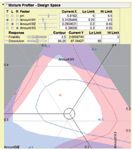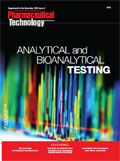Using a Systematic Approach to Select Critical Process Parameters
Critical process parameters (CPPs) and their associated process controls are crucial to drug development and process validation and to the evaluation of every manufacturing unit operation.
The systematic approach for CPP selection and use discussed in this article was developed in line with the International Conference of Harmonization (ICH) Q8, Q9, Q10, and Q11 guidelines, which recommend quality risk management and the identification of CPPs as part of drug quality and process control development (1–4).
Specifically, ICH Q8(R2) Section 2.5 on Control Strategy (1), states:
"…. These controls should be based on product, formulation and process understanding and should include, at a minimum, control of the critical process parameters and material attributes…. A comprehensive pharmaceutical development approach will generate process and product understanding and identify sources of variability. Sources of variability that can impact product quality should be identified, appropriately understood, and subsequently controlled. Understanding sources of variability and their impact on downstream processes or processing, in-process materials, and drug product quality can provide an opportunity to shift controls upstream and minimize the need for end product testing. Product and process understanding, in combination with quality risk management (see ICH Q9), will support the control of the process such that the variability (e.g., of raw materials) can be compensated for in an adaptable manner to deliver consistent product quality."
CPP selection has traditionally been difficult because of a lack of a systematic approach to the problem. CPPs can be found in media, upstream and downstream unit operations, and drug-product processing. Due to the large number of unit operations and media complexity, it is easy to overlook processing parameters and materials that may impact drug-substance and drug-product variation and CQAs. Failure to identify critical parameters can result in unexplainable variation during batch processing and lot acceptance.
Selecting CPPs
The key steps to selecting CPPs and their application to process control are as follows:
- Identify critical quality attributes (CQAs) for drug-product and substance
- Select API, excipients, materials, and container closure
- Define all unit operations and process flow
- Define all product and process specification limits
- Achieve acceptable results for method validation of all analytical methods
- Complete quality risk management for factor/response selection for all critical unit operations and materials
- Explore the design space for all key factors identified during the risk assessment using design of experiments (DOE) or other multivariate methods
- Determine the factor effect size and select all CPPs
- Evaluate CPPs for ease of control and practical application to process control.
These steps are considered in detail below.
CQA identification. CQAs are those attributes that are important to the quality of the drug product and that remain consistent with those used in clinical studies. The industry generally associates them with ICH parameters, such as identity, purity, potency, stability, and safety. CQAs provide the justification and rationale of what is critical to function and what ultimately needs to be controlled to assure compliance and fit for use. CQAs are the foundation upon which the CPPs must be associated. Line-of-site between CPPs and CQAs is considered a major component of the drug-development strategy.
Ingredient, materials, and container closure. Key parameters and analytical methods that measure the attributes of the API, excipients, key materials, and packaging/container closure must be examined using a quality risk-management (QRM) approach. This approach focuses on finding those attributes that will be crucial to maintaining the quality and stability of the drug substance and drug product. Key findings of this review will be added to the list of candidate process parameters that need to be controlled. Output of a QRM material assessment can help to generate candidate CPPs.
Unit operation process definition. Identification of all unit operations and their associated equipment sets and equipment capabilities in upstream and downstream processes are crucial when selecting those parameters that need to be controlled to assure potency and drug lot consistency. Small changes in time, temperature, pH, and other variables may result in changes to API characteristic, yield, and impurity profiles. Output of a QRM unit operation assessment will generate some candidate CPPs. Because biologics are extremely sensitive to processing, it is important that each unit operation is carefully evaluated for possible impacts to the large molecule and impurities.
Product and process specifications. Specification limits for the product and its process must be defined to protect the CQAs of the drug substance or drug product. These limits may be set based on a transfer function (e.g., how does X influence the Y response) from a characterization study or may be set statistically (based on some multiplier of sigma and/or risk) for those parameters that show no harm (i.e., clinical) and where variation is known. Specification limits will form a key basis for CPP determination. Specification limits are primarily defined for product control rather than for process control.
Validation of analytical methods. Limit of detection, limit of quantification, precision, and accuracy must be characterized for all analytical methods, and method validation must be completed. Once these steps are done, one can trust the numbers and know the error associated with any statistic of interest. Method validation should be done prior to product and process characterization studies and the design and implementation of process controls.
Quality risk management for materials and operations. A formal QRM process should be in place to systematically examine all materials and unit operations for their potential influence to drug CQAs. Risk-ranking and other QRM tools are used to identify factors and unit operations that hold the greatest risk. Scientific understanding and historical data are typically the basis upon which potential risks are identified and prioritized. Candidate CPPs may be identified in this process that will later need to be ruled in or out based on data and identified risk.

Figure 1: Factor response matrix and risk assessment.
Design-space characterization. Many of the previous steps provide inputs to effective design-space characterization and optimization. DOE and multifactor studies are used to understand the sensitivity of key product and process parameters relative to drug-product and drug-substance specification limits. Factor selection prior to DOE generation is the most important step in design-space characterization. The matrix shown in Figure 1 is used in the identification of the factors and responses that should be characterized and completed as part of risk assessment prior to DOE design. One should take care to open up the range of the X factors sufficiently to understand their influence on Y response and to be representative of the normal operational range of the process. Figure 2 shows a clear picture of the design space generated from a characterized process.

Figure 2: Design space characterization. The white area is within the specification limits while the shaded area is not.
Factor effect size and CPP selection. DOE and multifactor experiments can help to isolate the influence of every factor and interaction on the critical responses associated with the substance or product. Analysis of the DOE will generate the scaled estimates (one half the change in Y relative to the change in X) also known as half effects, as shown in Table I.

Table I: Scaled estimates for a purification step.
One can convert the scaled estimate into the full effect (total change in Y relative to change in X) and compare the full effect to the product specification tolerance. The formulas for conversion are as follows:
- Full Effect = Scaled Estimates * 2
- % of Tolerance = Abs (Scaled Estimates * 2) / (USL-* LSL) for two-sided limits
- % of Design Margin= Abs (Scaled Estimates * 2) / (Average-LSL) for one-sided LSL only
- % of Design Margin= Abs (Scaled Estimates * 2) / (USL-Average) for one-sided USL only
where, USL is the Upper Specified Limit, LSL is the Lower Specified Limit, and the average is the baseline process or product average from the DOE or other lots.
One possible justification for determining CPPs is given in the following example. To normalize and standardize the effect size, the percent of tolerance for two-sided specification limits and the percent of design margin for one-sided limits were used to evaluate the effect size of a factor and or interaction. Values of <10% were not considered practically significant. Values of 11–19% were considered to be key operating parameters and values >20% were considered to be CPPs critical to product, process and design performance, as shown in Table II. Although thresholds for criticality are somewhat arbitrary, they have been set relative to the design-space explored and as a percentage of the CQA attribute and therefore should have product performance relevance.

Table II: Values considered key operating parameters to product, process, and design performance.
Application of CPPs for control. CPP selection typically comes from several sources, including risk assessments, scientific knowledge, and characterization and optimization studies. Once all CPPs have been identified, the next step is to determine practical application of them for process control. Typical considerations include: ease of use and/or ease of adjustment; safety and other risk factors; on-line or in-line measurement; and off-line or near-line measurement. Just knowing that a factor is critical and knowing the relative effect size of the factor to the product specifications and CQAs is a great start but it is not sufficient. Care needs to be exercised to make sure the CPP factors can be used in a safe and effective way to consistently adjust process parameters to their intended targets. Linking statistical process control (SPC) and process analytical technology (PAT) methods to the sensitivities identified during CPP selection is a big plus and ties the adjustment method together with process monitoring and control methods (5).
Thomas A. Little, PhD, is president of Thomas A. Little Consulting, 12401 N Wildflower Lane, Highland, UT 84003, tel. 925.285.1847, drlittle@dr-tom.com
References
1. ICH, Q8 (R2) Pharmaceutical Development (2009).
2. ICH, Q9 Quality Risk Management (2006).
3. ICH, Q10 Pharmaceutical Quality System (2009).
4. ICH, Q11 Development and Manufacture of Drug Substances, Step 4 document (2012).
5. FDA, Guidance for Industry: PAT—A Framework for Innovative Pharmaceutical Development, Manufacturing, and Quality Assurance (2004).
